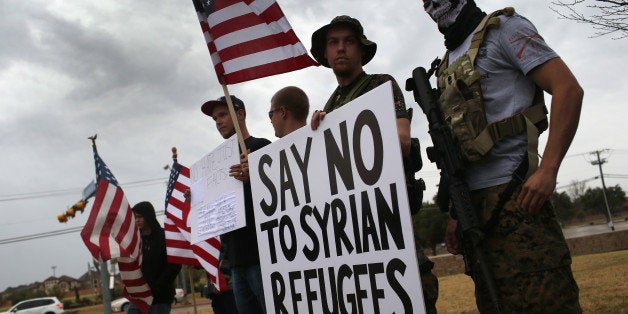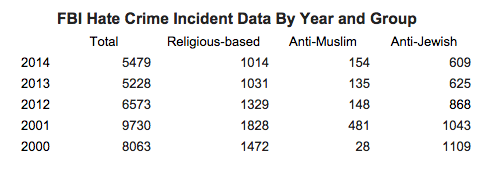
Special Report from Center for the Study of Hate & Extremism, California State University, San Bernardino
Average Monthly Totals of Anti-Muslim Hate Crime Nearly Triple
In the wake of the Paris terror attacks of November, 13 that left 130 dead and the San Bernardino, Calif. terror attack of December 2 that killed 14 and left another 22 wounded, anti-Muslim hate crime attacks appear to have risen sharply across the United States to a level nearly three times the monthly average of the last five years. These recent crimes have occurred nationwide and range from simple assaults on women dressed in hijabs and vandalisms, to arsons and shootings. On Monday, White House officials met with leaders from the Muslim and Sikh communities to exchange ideas about recent events of concern.
The number of reported anti-Islamic hate crimes over the last five years, as classified by police, has averaged 12.6 per month, with an average annual number of 150.8 according to Federal Bureau of Investigation (FBI) data. In the month following the Paris attacks, from November 13 to December 13, there have been at least 37 suspected hate crimes and eleven alone in the week following the San Bernardino terror attack. The 37 suspected hate crime cases are 2.94 times the average calendar monthly number seen from 2010-2014.
Current Data and Historical Perspective
This appears to be the highest monthly total since 2001, when there were 481 anti-Muslim hate crimes reported for the year, with most taking place after 9/11. The average monthly total for anti-Muslim hate crime for that year was 40.1, but the numbers for the last four months of 2001 were far higher. Nationwide official data collection for hate crime started in a limited rollout in 1991, after President George Bush signed the Hate Crime Statistics Act the previous year.
The FBI now defines a hate crime as "criminal offenses motivated, in whole or in part, by the offender's bias against" a particular group such as a religion, race or sexual orientation. The data is collected without regard to the coverage of state hate crime law, and 45 states and the federal government have some type of hate crime statute.
The latest official national data, released by the FBI earlier this fall covers calendar year 2014. There have been a total of 754 anti-Muslim hate crimes from 2010 to 2014 according to the FBI. Last year the FBI reported a total of 5479 hate crimes in the United States, a drop of 13% from 2013, while anti-Muslim crimes increased from 135 in 2013 to 154 in 2014. Since 2002 anti-Muslim hate crime incidents have ranged between 105 (2008) and 160 (2010). While overall reported hate crime in 2014 is at its lowest levels since 1991, when the program started, only 1,666 agencies actually reported any hate crime at all, the lowest level this century as well. Various states and cities with large populations do not appear to meaningfully participate in the
voluntary reporting program.
Anti-Muslim hate crimes have been the second most common anti-religious crimes after anti-Jewish attacks since 9/11. While estimates of the Muslim American population vary widely, the Pew Research Center puts the number at just under 3 million, accounting for 0.9 percent of the overall population, with Jews at 1.9 percent.
Victim Surveys Point to Massive Underreporting
Other research indicates that there is massive underreporting with respect to the official FBI data. The federal government uses two indexes to measure crime across the nation. The FBI compiles crimes reported to police through their Uniform Crime Reporting system and was reported above. The other index from the Bureau of Justice Statistics (BJS) attempts to cover crimes, even when they are not reported to police or are misreported by them, through massive household victimizations surveys across the nation. In contrast to the FBI figures, the BJS victimization surveys, which rely on self reported victim assessments, are far higher.
In 2012 the BJS estimated that there were 293,800 hate crimes overall across the nation, annually, with 60 percent not reported to police. In 2012 BJS reports that 90 percent of hate crimes involved violence and that 24 percent of those involved a weapon. In contrast to crime in general only about ten percent are direct against persons with the rest directed against property.

The Center for the Study of Hate & Extremism confirmed and analyzed apparent hate crimes reported in the media and by civil rights groups across the United States in the month following the Paris attacks using FBI hate crime reporting standards and criminal law definitions provided by the American Law Institute's Model Penal Code. While not binding, the Model Penal Code assists state legislatures in drafting uniform criminal statutes and is used in law schools to teach about offenses.
List of Suspected Hate Crimes Directed at Actual or Perceived Muslim Institutions or Individuals Since Paris AttacksParis, France Terror Attacks, November 13, 2015
1.11/13Mission Valley, CAFemale Simple Assault Assault2.11/15 Meriden, CTMosque AttackCriminal Mischief, Threat, Shots Fired
3.11/15 Orlando, FLResidence/Shots FiredCriminal Mischief, Att. Assault, Threat
4.11/15Norman, OKPhone Threat/Shots at PoliceThreat; Assault w/deadly weapon
5.11/15 Charlotte, NCAttack on Uber driverAggravated Assault
6.11/16 Pflugerville, TXMosque desecrationThreat, Criminal Mischief
7.11/16 Omaha, NEMosque vandalismCriminal Mischief
8.11/16 Cincinnati, OHThreat via vehicleAtt. Agg. Assault, Threat
9.11/17 St. Petersburg, FLBomb/gun Phone Threat Threat
10.11/17 Ft. Bend County, TX Mosque ThreatThreat
11.11/17 Dearborn, MITwitter threatThreat
12.11/18 San Antonio, TXMosque DisruptionCriminal Trespass
13.11/19 Falls Church, VAFake bomb, vandalismCriminal Mischief, Threat
14.11/19 The Bronx, NYAssault on elementary student Assault
15.11/20 San Diego, CAAssault on student wearing hijab Assault
16.11/20Corpus ChristiMosque ThreatThreat
17.11/20Brooklyn, NYSpit on women/threatAssault/Threat
18.11/26 Pittsburgh, PACab driver shotAttempted Murder
19.12/1 Anaheim, CABullet riddled Quran at businessThreat
San Bernardino Terrorist Attack, December 2, 2015
20.12/3 Palm Beach, FLAll windows smashed at MosqueCriminal Mischief
21.12/5 Astoria, NYStore owner beatenAssault, Threat
22.12/5 Washington, DCMuslim Cong. Carson death threatThreat
23.12/6 Buena Park, CASikh TempleVandalism, Crim. Mischief
24.12/7 West Phila., PAPigs headCrim. Mischief/Threat
25.12/7 Alameda Cnty., CAHot coffee attack, slursAssault
26.12/7 New York, NYRestaurant worker slappedAssault, Att. Crim. Mischief
27.12/8 Jersey City, NJThreat letterThreat
28.12/8 Grand Forks, ND Arson, Nazi spray paintArson, Criminal Mischief
29.12/9 Seattle, WARide share driver attackedAssault
30.12/9 Brooklyn, NYWoman kicked, slursAssault
31.12/10 Washington, DCCAIR gets letter w/powderThreat
32.12/10 Santa Clara, CACAIR gets letter w/powderThreat
33.12/10 Tampa, FLRocks/shots at 2 Muslim driversAssault, Threat
leaving relig. service in hijab34.12/11 Coachella, CAMosque FirebombArson
35.12/13 Hawthorne, CAMosque fence spray painted/fake grenade Criminal Mischief/Threat
36.12/13 Grand Rapids, MI Robbery/ ShootingRobbery/ Aggravated Assault
37.12/13 HawthorneSecond mosque spray paintedCriminal Mischief
38.12/15 Chino Hills, CAThreat with knifeAtt. Aggravated Assault
39.12/16 Salt Lake City, UTBusiness vandalismCriminal Mischief
40.12/16So. Salt Lake City, UT Business vandalism/SwastikasCriminal Mischief
Criminal Incidents By Type*
Threat 21
Assault 15
Criminal Mischief 11
Arson2
*An incident can have more than one offense.
Incidents by State
California 9
New York 5
Texas 4
Florida4
Crimes Come At Time of Widespread Anti-Muslim Prejudice
It is not unusual for hate crimes to spike following a publicized instance of intergroup violence. As I wrote in 1992 for Stanford Law & Policy Review, hate crimes "have an alarming potential to ignite community disorder... [and] the scope of violence can escalate quickly." In a new issue of American Behavioral Scientist, Jack Levin and Ashley Reichelmann stated, "Our results indicated that hate-motivated assaults in the aftermath of 9/11 seemed to be driven to an increasing extent by a series of group threats in the wider society."
As hate offenders rely, in part, on harmful stereotypes in the overall culture to craft and direct hatreds, the rise in hate crimes may very well be the symptom of a climate that is increasingly hostile to Muslim Americans' meaningful inclusion in civil society.
Over the past few months, candidates have boldly argued for, and sometimes backtracked on, banning Muslim entry to the United States, shuttering mosques, registering Muslims in databases, killing relatives of terrorists, denying entry to orphan children, waterboarding, creating a government agency to promote "Judeo-Christian Western values" as well establishing a religious test for refugee admission and the presidency. Ben Carson likened Muslim refugees to rabid dogs.
Recent opinion polls after the Paris attacks indicate that terrorism is now the most important current issue for Americans. Gallup for instance has found that 51 percent of Americans are worried about being victims of terrorism, the highest since 2001. A majority of Americans, 59 percent, disapprove of the President's handling of ISIS according to a December 13 Washington Post/ABC News poll. These anxieties come at a time when American Muslims face widespread prejudice. Another Gallup poll found that 43 percent of respondents had prejudiced views against Muslims. The Washington Post/ABC News poll found that 36 percent of those surveyed favored bans on Muslim immigration to the United States. The poll also indicated that 28 percent of respondents stated that even mainstream Islam encourages violence, double that of a 2002 poll. Other social science data supports the notion of widespread anti-Muslim prejudice. According to the New York Times, "In November, there were about 3,600 searches in the United States for "I hate Muslims" and about 2,400 for "kill Muslims.'" Researchers, writing in the New York Times estimated that there will be 200 anti-Muslim hate crimes this year, the highest since 2001.
Appendix:
FBI Criteria
"The FBI Uniform Crime Reporting (UCR) Program collects hate crime data regarding criminal offenses motivated, in whole or in part, by the offender's bias against a race, religion, disability, sexual orientation, ethnicity, gender, or gender identity. Due to the difficulty of ascertaining the offender's subjective motivation, bias is to be reported only if investigation reveals sufficient objective facts to lead a reasonable and prudent person to conclude that the offender's actions were motivated, in whole or in part, by bias."
"Motivation is subjective, therefore, it is difficult to know with certainty whether a crime was the result of the offender's bias. For that reason, before an incident can be reported as a hate crime, sufficient objective facts must be present to lead a reasonable and prudent person to conclude that the offender's actions were motivated, in whole or in part, by bias. While no single fact may be conclusive, facts such as the following, particularly when combined, are supportive of a finding of bias:
1. The offender and the victim were of a different race, religion, disability, sexual orientation, ethnicity, gender, and/or gender identity. For example, the victim was African American and the offender was white.
2. Bias-related oral comments, written statements, or gestures were made by the offender indicating his or her bias. For example, the offender shouted a racial epithet at the victim.
3. Bias-related drawings, markings, symbols, or graffiti were left at the crime scene. For example, a swastika was painted on the door of a synagogue, mosque, or LGBT center.
4. Certain objects, items, or things which indicate bias were used. For example, the offenders wore white sheets with hoods covering their faces or a burning cross was left in front of the victim's residence.
5. The victim is a member of a specific group that is overwhelmingly outnumbered by other residents in the neighborhood where the victim lives and the incident took place.
6. The victim was visiting a neighborhood where previous hate crimes had been committed because of race, religion, disability, sexual orientation, ethnicity, gender, or gender identity and where tensions remained high against the victim's group.
7. Several incidents occurred in the same locality, at or about the same time, and the victims were all of the same race, religion, disability, sexual orientation, ethnicity, gender, or gender identity.
8. A substantial portion of the community where the crime occurred perceived that the incident was motivated by bias. "
Model Penal Code Offenses
Section 220.1. Arson and Related Offenses.
(1) Arson. A person is guilty of arson, a felony of the second degree, if he starts a fire or causes an explosion with the purpose of:
(a)destroying a building or occupied structure of another;
Section 220.3. Criminal chief.
(1) Offense Defined. A person is guilty of criminal mischief if he:
(a) damages tangible property of another purposely, recklessly, or by negligence in the employment of fire, explosives, or other dangerous means listed in Section 220.2(1); or
(b) purposely or recklessly tampers with tangible property of another so as to endanger person or property; or
(c) purposely or recklesslycauses another to suffer pecuniary loss by deception or threat.
(2) Grading. Criminal mischief is a felony of the third degree if the actor purposelycauses pecuniary loss in excess of $5,000, or a substantial interruption or impairment of public communication, transportation, supply of water, gas or power, or other public service.
Section 211.1. Assault.
(1) Simple Assault. A person is guilty of assault if he:
(a) attempts to cause or purposely, knowingly or recklessly causesbodily injury to another; or
(b) negligentlycausesbodily injury to another with a deadly weapon; or
(c) attempts by physical menace to put another in fear of imminent serious bodily injury.
Simple assault is a misdemeanor unless committed in a fight or scuffle entered into by mutual consent, in which case it is a petty misdemeanor.
(2) Aggravated Assault. A person is guilty of aggravated assault if he:
(a) attempts to cause serious bodily injury to another, or causes such injury purposely, knowingly or recklessly under circumstances manifesting extreme indifference to the value of human life; or
(b) attempts to cause or purposely or knowingly causes bodily injury to another with a deadly weapon.
Aggravated assault under paragraph (a) is a felony of the second degree; aggravated assault under paragraph (b) is a felony of the third degree.
Section 211.3. Terroristic Threats.
A person is guilty of a felony of the third degree if he threatens to commit any crime of violence with purpose to terrorize another or to cause evacuation of a building, place of assembly, or facility of public transportation, or otherwise to cause serious public inconvenience, or in reckless disregard of the risk of causing such terror or inconvenience.
